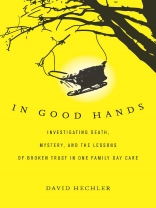How can you be sure that your child in day care is safe?
a) The day care I chose was highly recommended.
b) It’s fully licensed and government-approved.
c) My son’s provider loves him as much as I do.
d) All of the above.
e) None of the above.
The correct answer is “none of the above.” Recommendations may be helpful in selecting a facility, but they’re no assurance your child will be safe. The government may check, but...
How can you be sure that your child in day care is safe?
a) The day care I chose was highly recommended.
b) It’s fully licensed and government-approved.
c) My son’s provider loves him as much as I do.
d) All of the above.
e) None of the above.
The correct answer is “none of the above.” Recommendations may be helpful in selecting a facility, but they’re no assurance your child will be safe. The government may check, but you can’t count on the government to effectively monitor day care. And banking on a provider’s good will is no substitute for your own watchful eyes.
In Good Hands is a book about the importance of safe day care. It’s also the story of one family day care that parents loved even after a baby died. They continued to drop off their children after a second infant died in the home. Doctors ruled that both children were victims of sudden infant death syndrome, but that didn’t stop the police from launching a criminal investigation.
What followed was a medical and psychological mystery that divided a South Carolina community. The twists and turns rival the best crime fiction. Three murder trials over six years didn’t answer all the questions—or banish lingering doubts.
This is a book full of questions. There is still disagreement about what happened in that home, and who (if anyone) was responsible. The book also explores the challenges parents face when hiring a caregiver, and the emotional bonds they sometimes develop that can make severing the relationship agonizing—even when children’s lives may be at stake.
This is also a book filled with answers. It offers a wealth of advice from experts who urge parents not to assume that their job is done after they select a facility. That’s when the real work begins.
The Appendix at the end of the text features interviews with two therapists. As the second interview makes clear, the lessons in these pages aren’t limited to parents of young children. They are just as valuable for people seeking safe care for other vulnerable individuals, like the elderly or people with disabilities.












